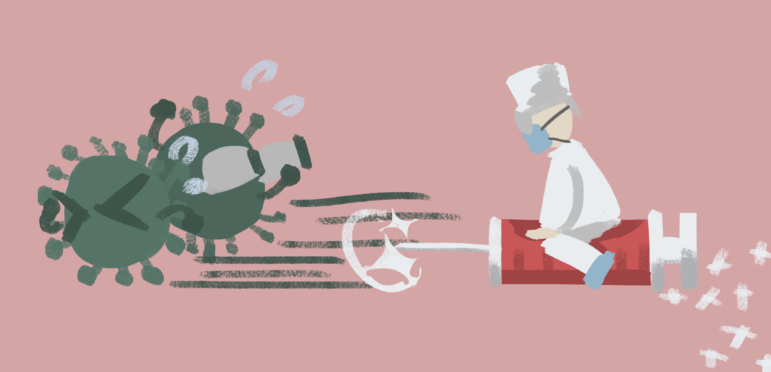

Nearly everyone I know has elaborate plans for “when we get vaccinated” or “when COVID-19 is over.” To many, these are the same thing: once everyone is vaccinated, we can return to normal life. But vaccines are not the silver bullet we want them to be. We should look beyond them to implement measures here and now, such as masks, testing, contact tracing, self-quarantining and self-isolating.
Public health experts agree that to return to pre-pandemic “normalcy” most people must be vaccinated or infected. The issue is that we’re months away from vaccinating enough people to stop the spread of COVID-19: allowing millions of people to continue getting infected will lead to a catastrophic death toll. President Joe Biden predicts vaccines will become available to all adults near the end of May, but distributing those vaccines will take several additional months. Vaccines probably won’t be available for those under 16 until September, and countries that cannot afford vaccines could be waiting years. In the meantime, hundreds of thousands will die.
SARS-CoV-2 will continue to mutate after vaccines are distributed, possibly slipping out of the vaccine’s protection. It has already started: Variant B. 1.351, first found in South Africa, has a mutation that reduces the efficacy of AstraZeneca’s and Johnson & Johnson’s vaccines. The same may apply to Moderna’s and Pfizer’s vaccines. Many immunologists agree that we’ll be forced to update and redistribute our vaccines year after year to combat a changing virus.
With this in mind, we shouldn’t wait for a vaccine to end the pandemic. COVID-19 has spread too far to make total containment possible, but there are still measures we can take to save lives and even partially “open up” closed businesses or schools. This starts at the personal level, with masks.
Masks work. Surgical masks and similar cloth masks are estimated to be 67% effective at protecting the wearer. Creating a better fit by double masking or using a mask fitter can increase a mask’s efficacy. Most importantly, masks protect those around us by catching virus-laden droplets (aerosols) before they reach others, as the spread of droplets is the most common way SARS-CoV-2 spreads.
Aerosols can linger for hours in unventilated spaces, so wearing a mask whenever you’re in public is important. Once you’re fully vaccinated (two weeks after the final dose), the Centers for Disease Control and Prevention say that it’s safe to socialize without social distancing or masks with vaccinated or local, low-risk people (provided there is only one unvaccinated household present). Otherwise, the CDC recommends that you continue wearing a mask in public. Data from Israel shows that Pfizer’s vaccine is 94% effective against asymptomatic infection, suggesting that the vaccine prevents transmission of SARS-CoV-2, but the CDC believes that precautions should continue to be taken.
“Aerosols can linger for hours in unventilated spaces, so wearing a mask … in public is important”
Testing, contact tracing, self-quarantining, which entails separating a person exposed to COVID-19 from others, and self-isolation, separating a person known to have COVID-19 from others, are crucial to a safe reopening. One model by Alyssa Bilinski, M.S., Farzad Mostashari, M.D. and Joshua Salomon, Ph.D. found that if we bring symptomatic infection detection, contact identification, isolating and quarantining up to 90%, then transmission of SARS-CoV-2 would be reduced by 46%. Though this is an unlikely scenario, there are ways to boost the current testing and tracing system so that when coupled with other measures it will make an impact.
Antigen tests (paper strip tests that people can administer to themselves) are cheaper and faster than the more commonly used PCR tests, leading several to suggest that they be used instead despite their slightly lower accuracy. Providing these tests for free to all households allows us to catch cases before they spread the virus further.
Contact tracing applications, which alert you if you’ve been in close proximity to a confirmed COVID-19 case, can boost the number of contacts found: a few studies have shown that they catch roughly twice the number of contacts as manual contact tracing does. Currently, only 20% of Californians have adopted CA Notify, the state’s contact tracing application. We need to use applications like this.
Of course, the efficacy of testing and contact tracing relies on our willingness to self-quarantine and self-isolate. Compared to the widespread lockdowns of past months however, this is a small sacrifice to make. The government should facilitate compliance by offering rooms to those in communal housing or other situations where they cannot isolate, though in the end the responsibility is ours.
A complex problem such as the COVID-19 pandemic necessitates a multipronged solution. Vaccines are necessary but not perfect. Masks, testing and contact tracing, if implemented months ago, could have saved hundreds of thousands of lives. It’s not too late now. If everyone does their part to keep others safe, we’ll save lives and bring ourselves closer to normality.



